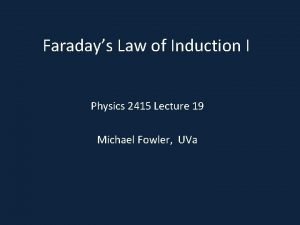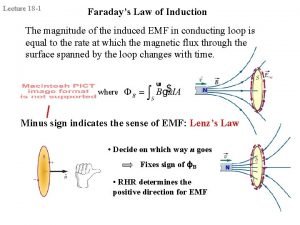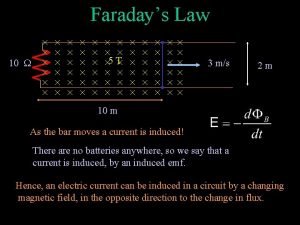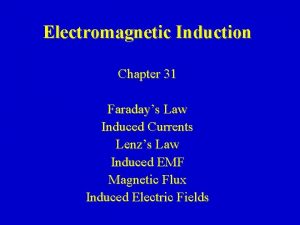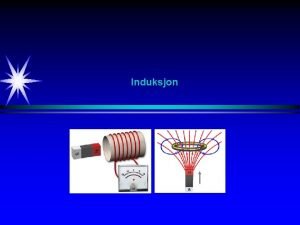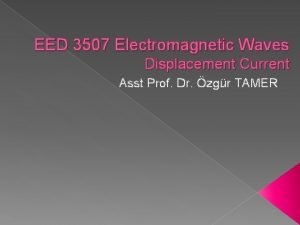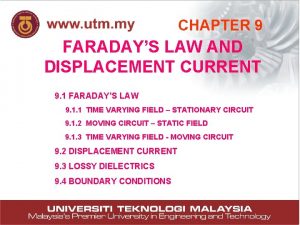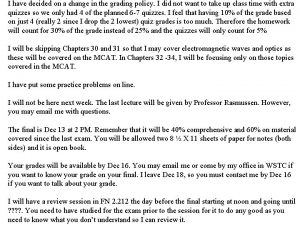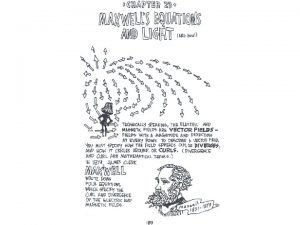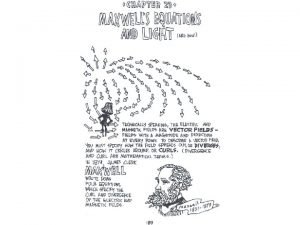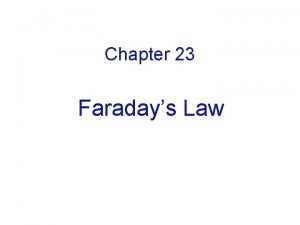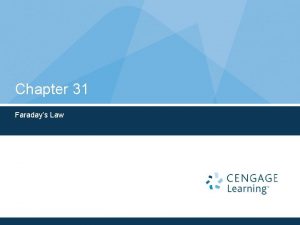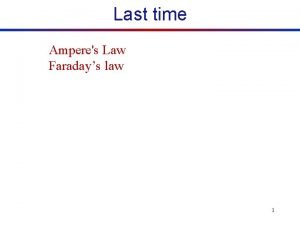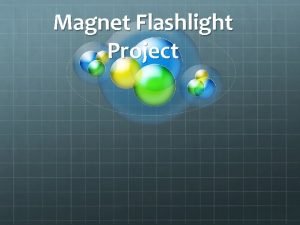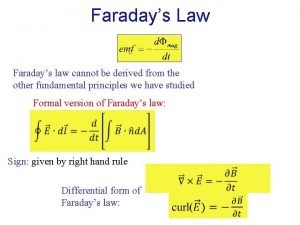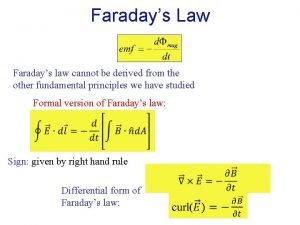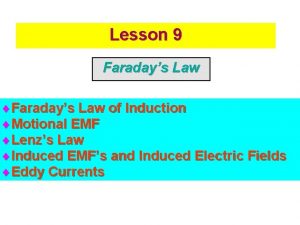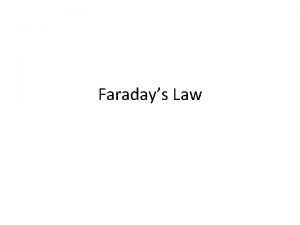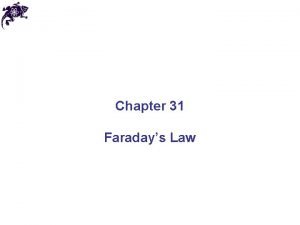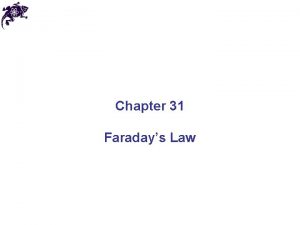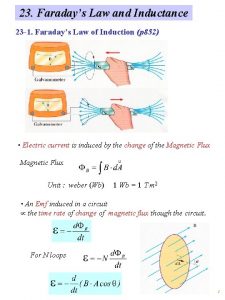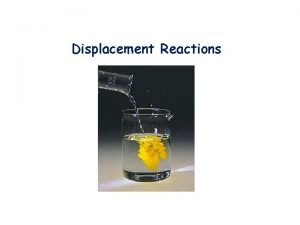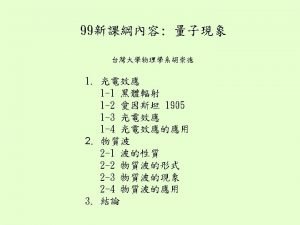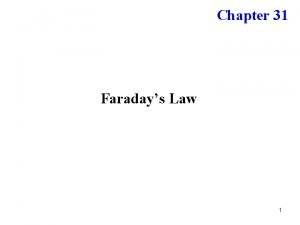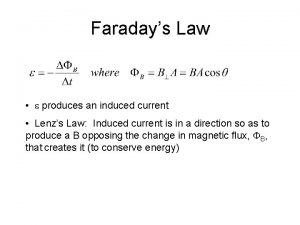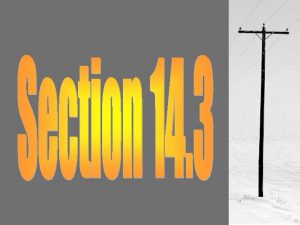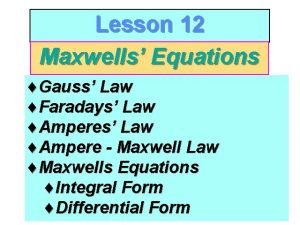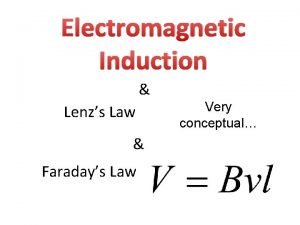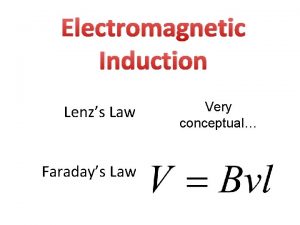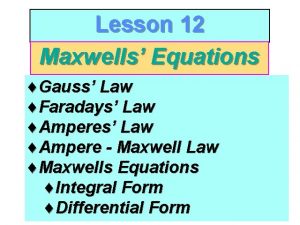CHAPTER 9 FARADAYS LAW AND DISPLACEMENT CURRENT 9
























- Slides: 24

CHAPTER 9 FARADAY’S LAW AND DISPLACEMENT CURRENT 9. 1 FARADAY’S LAW 9. 1. 1 TIME VARYING FIELD – STATIONARY CIRCUIT 9. 1. 2 MOVING CIRCUIT – STATIC FIELD 9. 1. 3 TIME VARYING FIELD - MOVING CIRCUIT 9. 2 DISPLACEMENT CURRENT 9. 3 LOSSY DIELECTRICS 9. 4 BOUNDARY CONDITIONS 1

9. 0 FARADAY’S LAW AND DISPLACEMENT CURRENT Two topics will be discussed : (i) Faraday’s Law – about the existence of electromotive force (emf) in the magnetic field (ii) Displacement current – that exists due to time varying field That will cause the modification of Maxwell’s equations (in point form - static case) studied previously and hence becomes a concept basic to the understanding of all fields in electrical engineering.

9. 1 FARADAY’S LAW Michael Faraday – proved that if the current can produce magnetic field, the reverse also will be true. Proven only after 10 years in 1831. The magnetic field can produce current in a loop, only if the magnetic flux linkage the surface of the loop is time varying. Faraday’s Experiment : Loop Flux linkage Galvanometer + Battery

Loop Flux linkage • Current produced magnetic field and the magnetic flux is given by : - + (1) Galvanometer Battery • No movement in galvanometer means that the flux is constant. • Once the battery is put off – there is a movement in the galvanometer needle. • The same thing will happen once the battery is put on - but this time the movement of the needle is in the opposite direction. Conclusions : The current was induced in the loop - when the flux varies - once the battery is connected - if the loop is moving or rotating

Induced current will induced electromotive voltage or induced emf Vemf given by : (2) where N = number of turns Loop Flux linkage Equation (2) is called Faraday’s Law - + Galvanometer Battery Lenz’s Law summarizes the –ve sign is that : The induced voltage established opposes the flux produced by the loop.

In general, Faraday’s law manifests that the Vemf can be established in these 3 conditions : • Time varying field – stationary circuit (Transformer emf) • Moving circuit – static field (Motional emf) • Time varying field - Moving circuit (both transformer emf and motional emf exist)

9. 1. 1 TIME VARYING FIELD – STATIONARY CIRCUIT (TRANSFORMER EMF) (3) increases I Vemf = the potential difference at terminal 1 and 2. 1 R From electric field : 2 induced (4) If N = 1 : Diagram shows a circle loop with the surface area S placed in the magnetic field (5)

Using Stoke’s theorem : (6) Hence Maxwell’s equation becomes : (7)

9. 1. 2 MOVING CIRCUIT – STATIC FIELD (MOTIONAL EMF) Force : Moving bar Diagram shows a bar moving with a velocity in a static field. Hence : Fleming’s Right hand rule Thumb – Motion 1 st finger – Field Second finger - Current

9. 1. 3 TIME VARYING FIELD - MOVING CIRCUIT Both transformer emf and motional emf exist

Ex. 9. 1 : A coducting bar moving on the rail is shown in the diagram. Find an induced voltage on the bar if : (i) A bar position at y = 8 cm and (ii) A bar moving with a velocity and (iii) A bar moving with a velocity and P y 0 6 cm x Q

Solution : P y 0 (i) Transformer case : 6 cm x Q z y x According to Lenz’s law when increases point P will be at the higher potential with respect to point Q. (B induced will oppose the increasing ) (ii) Motional case : Remember : the direction of is opposed the current induced in the loop.

P y 0 (iii) Both transformer and motional case : 6 cm x Q z y x

From trigonometry :

9. 2 DISPLACEMENT CURRENT From continuity of current equation : and ; Hence : and

R where : + = Conduction current density - Jc Jd Dielectric C +Q -Q = Displacement current density Hence : Therefore from Faraday’s law and the concept of displacement current we can conclude that both the magnetic and electric fields are interrelated.

Maxwell’s Equations Differential Form Integral Form Label Faraday’s Law Ampere’s Circuital Law Gauss’S Law for Electric Field Gauss’s Law for Magnetic Field An integral form of Maxwell’s equation can be found either by using Divergence Theorem or Stoke Theorem. All electromagnetic (EM) waves must conform or obey all the four Maxwell’s equations.

Ex. 9. 2: A parallel plate capacitor having a plate area of 5 cm 2 and where the plates are separated by a distance of 3 mm is connected to a supply voltage, 50 sin 103 t Volt. Calculate the displacement current if the dielectric permittivity between the plate is. Solution :

This example is to show the use of Maxwell’s equation and the inter relation of electric field and magnetic field. Ex. 9. 3: Given a magnetic medium with characteristics has. Find and. Solution : ;

Compare : Hence :

9. 3 LOSSY DIELECTRICS Main function of dielectric material is to be used as an insulator. Compare (1) and (2) : For a perfect dielectric : Hence Maxwell’s equation : (1) For lossy dielectric : (2) where : Loss tangent is the ratio of the magnitude of the conduction current density to the magnitude of the displacement current density = loss tangent

A lossless capacitor has a loss tangent of zero. For lossy capacitor, an equivalent circuit can be replaced by its equivalent resistance in parallel with a perfect capacitor as shown in the diagram : + + + R - -ve - - C Leakage current From page 110 & 111 and Hence loss tangent :

Ex. 9. 4: Find the average power loss per unit volume for a capacitor having the following properties; dielectric constant 2. 5 loss tangent 0. 0005 for an applied electric field intensity of 1 k. V/m at frequency 500 MHz. Solution :

9. 4 BOUNDARY CONDITIONS Boundary conditions for time varying field are the same as boundary conditions in electrostatics and magnetostatics fields. Tangential components for and Normal components : If medium 2 is perfect conductor : Hence : :
 What is induction in physics
What is induction in physics Faraday's law
Faraday's law Faraday's law
Faraday's law Faraday equation
Faraday equation Single displacement vs double displacement
Single displacement vs double displacement Magnetism equations
Magnetism equations Electrochemistry tutorial
Electrochemistry tutorial Faradays induksjonslov
Faradays induksjonslov Newton's first law and second law and third law
Newton's first law and second law and third law Newton's first law
Newton's first law Maximum displacement current
Maximum displacement current Electric displacement current
Electric displacement current Displacement current.
Displacement current. Displacement current formula
Displacement current formula What is displacement current
What is displacement current Displacement current
Displacement current A balanced delta connected load having an impedance 20-j15
A balanced delta connected load having an impedance 20-j15 Difference between phase voltage and line voltage
Difference between phase voltage and line voltage Semiconductor
Semiconductor Line current and phase current
Line current and phase current Drift vs diffusion current
Drift vs diffusion current Intrinsic semiconductor
Intrinsic semiconductor Balanced delta-wye connection
Balanced delta-wye connection Slideplayer
Slideplayer Drift current and diffusion current in semiconductor
Drift current and diffusion current in semiconductor
